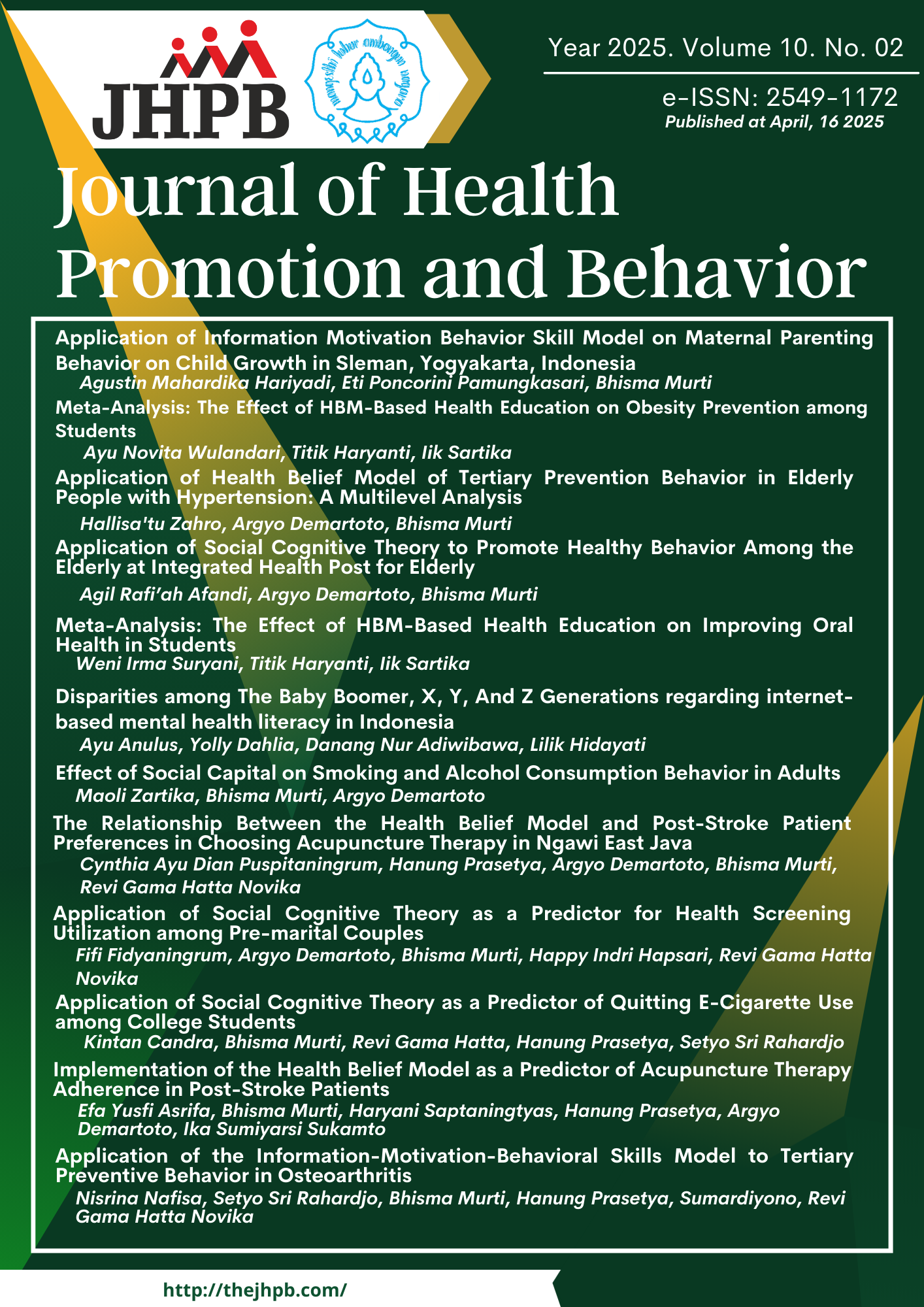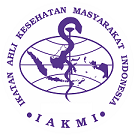Implementation of the Health Belief Model as a Predictor of Acupuncture Therapy Adherence in Post-Stroke Patients
DOI:
https://doi.org/10.26911/thejhpb.2025.10.02.11Abstract
Background: Post-stroke symptoms include limb weakness, paralysis, loss of balance, pain and numbness, memory and cognitive disorders, and urinary and digestive problems. The recovery process in post-stroke patients takes a long time, therefore, the patient needs to adhere to acupuncture therapy for recovery. This study aims to analyze the influence of perceived susceptibility, perceived severity, perceived benefits, perceived barriers, self-efficacy, and cues to action on acupuncture therapy adherence in post-stroke patients.
Subjects and Method: This study was a cross-sectional study conducted in Yogyakarta, from November to December 2024. A total of 205 patients were selected using random sampling. The dependent variable was adherence to acupuncture therapy in post-stroke patients. Independent variables were perceived vulnerability, perceived severity, perceived benefits, perceived benefits, self-efficacy, and cues to action. The data were analyzed using path analysis.
Results: Adherence to acupuncture therapy increased with increased perceived susceptibility (b= 1.19; 95% CI= -0.13 to 2.27; p=0.081), perceived severity (b= 2.16; 95% CI= 0.81 to 3.31; p= 0.001), perceived benefits (b= 1.71; 95% CI= 0.98 to 2.45; p<0.001), self-efficacy (b= 0.73; 95% CI= 0.11 to 1.36; p= 0.022) and cues to action (b= 1.77; 95% CI= 1.08 to 2.45; p<0.001).
Conclusion: There is a positive relationship between perceived susceptibility, perceived severity, perceived benefits, self-efficacy, and cues to action on adherence to acupuncture therapy in post-stroke patients. The perceived benefits and self-efficacy are a direct influence on adherence to acupuncture therapy in post-stroke patients, while the perceived susceptibility, perceived severity, and cues to action are indirect influences.
Keywords:
Health Belief Model, Adherence, Acupuncture Therapy, Post StrokeHow to Cite
References
Amry RY, Hikmawati AN, Rahayu BA (2021). Teori health belief model digunakan sebagai analisa kepatuhan minum obat pada penderita hiper-tensi. Jurnal Keperawatan. 13(1): 25-34. https://doi.org/10.32583/kepera-watan.v13i1.973
Asfy I, Primanita RY (2024). Gambaran health belief model pada pasien stroke di pengobatan tradisional ustad X. CAUSALITA : Journal of Psychology. 1(4): 123–131. https://do-i.org/10.62260/causalita.v1i4.139
Pratama BA, Wahyuningsih SS (2022). Analysis of Knowledge with Compli-ance in Implementing Protocols of COVID-19 in SMP Negeri 4 Suko-harjo's Students. Gaster. 20 (1): 11-21. https://doi.org/10.30787/gaster.v20i1.743.
Christiandari H, Supadmi W, Sudibyo J. (2022). Hubungan medication related burden dengan kepatuhan terapi pada pasien stroke di Rumah Sakit PKU Muhammadiyah Gamping. Akfarindo. 7(2): 52–59.
Darmawan A, Berawi KN, Karimah N, Wahyudo R (2019). Efektifitas terapi akupunktur terhadap penderita hiper-tensi. J Agromedicine Unila. 6: 332–336.
Dyfani A, Lahdji A, Romadhoni (2023). The effect of perceived benefit and perceived barrier on activity of daily living in non-hemorrhagic stroke post patients. ISOCMED: 182–189. Htt ps:-//doi.org/10.17501/3021677x.2023.1122.
Marhenta YB, Seran K, Waalujo D, Galisa C. (2024). Perilaku pasien hipertensi dalam penggunaan obat anti hiper-tensi dengan menggunakan health belief model di Pesantren II. Jurnal Manajemen Kesehatan Yayasan RS. Dr. Soetomo. 10(1): 181–190.
Prabawati RA, Widjanarko B, Prabamurti PN (2022). Faktor - faktor yang ber-hubungan dengan kepatuhan pen-derita hipertensi dalam melaksanakan terapi di Puskesmas Bandarharjo. MKMI: 405–410.
Prasetya H, Murti B, Anantanyu S, Syam-sulhadi M (2018). The effect of hyp-nosis on adherence to antitu bercu-losis drugs using the health belief model. Int J of Clin Exp Hyp, 66(2): 211–227. https://doi.org/10.1 080/0-0207144.2018.1421361
Rachmawati WC (2019). Promosi kese hat-an dan ilmu perilaku. Penerbit Wineka Media.
Rosaline M, Rahmah NA (2023). Hubung-an health belief dan health literacy dengan kepatuhan pengo batan pada penderita hipertensi. MAHESA. 3(3): 572–585. https://do i.org/10.33024/-mahesa.v3i3.9876
Shabibi P, Sadegh M, Zavareh A, Sayehmiri K, Qorbani M, Rastegarimehr B, Man-sourian M (2017). Effect of educatio-nal intervention based on the health belief model on promoting self-care behaviors of type-2 diabetes patients. Electron Phsyician. 9(12):5 960-5968. https://doi.org/10.19082/ 5960.
Sutin U, Paluangrit S, Dangkrajang S, Sutthinarakorn W, Prasert V. (2022). Problems and needs when caring for stroke patient at homes. IJPHS. 11(2): 695–705. https://doi.org/10.11591/i-jphs.v11i2.21013
Suwaryo PAW, Widodo WT, Setianingsih E. (2019). The risk factors that influence the incidence of stroke. Jurnal Kepe-rawatan. 11(4): 251–260. http s:// doi.-org/10.32583/keperawatan.v11i4.530.
Tharek Z, Ramli AS, Whitford DL, Ismail Z, Mohd Zulkifli M, Ahmad Sharoni SK, Shafie AA, Jayaraman T. (2018). Rela tionship between self-efficacy, self-ca re behavior and glycaemic control among patients with type 2 diabetes mellitus in the Malaysian primary care setting. BMC Fam Pract. 19(1): 1–10. https://doi.org/10.1186/s12875-018-0725-6
Ulandari R, Soebyakto B (2019). Peran keluarga merawat lanjut usia pasca stroke. Masker Medika. 7(2). https: //-doi.org?10.52523/maskermedika.v7i2
Vazini H, Barati M (2015). The health belief model and self-care behaviors among Type 2 Diabetic Patients. Iran J Dia-betes Obes. 6(2): 107–113. Htt ps://-ijdo.ssu.ac.ir/article-1-195-en.p df.
Wahyuni R, Iqbal KKW. (2023). Analisis kepatuhan pasien hipertensi dalam pengobatan dari perspektif health belief model di Puskesmas X Provinsi Jambi. Kesehatan Medika Saintika. Jurnal Kesehatan Medika Saintika. 14: 34–42.
Wahyuni S, Apriyanto BS, Pujiastutik YE. (2024). Knowledge, self-efficacy and self-management behavior in post-stroke patients at Kediri Hospital: A Cross-Sectional Study. Jurnal Sin-tesis: Penelitian Sains dan Kesehatan. 5(2): 167–175. https://do i.org/10.56-399/jst.v5i2.217.
Yuliani RD, Prasetya H, Murti B. (2022). Meta analysis: application of health belief model theory on covid-19 acept-ance in general population. J Health Promot Behav. 7(3): 225–237. https:-//doi.org/10.26911/thejhpb.2022.07.03.05.





